Description
In ancient times it was called Sinus Laus, from the polis of Magna Grecia Laos, located, however, in Santa Maria al Cedro, beyond the Gulf of Policastro. Today the gulf takes its name from the town of Policastro Bussentino (now part of the municipality of Santa Marina), the ancient Pixous of Magna Grecia and later known as Buxentum in Roman times.
The entire Tyrrhenian coast of Basilicata overlooks the Gulf of Policastro, dominated to the north by the Massiccio del Sirino. The main municipalities are Sapri (SA) in Campania, Maratea (PZ) in Basilicata, Praia a Mare and Scalea (CS) in Calabria. The Campania section of the gulf falls partly within the Cilento and Vallo di Diano National Park.

Magna Graecia was the name given by the Romans to the Greek-speaking coastal areas of Southern Italy in the present-day Italian regions of Calabria, Apulia, Basilicata, Campania and Sicily; these regions were extensively populated by Greek settlers. These settlers, who began arriving in the 8th century BC, brought with them their Hellenic civilization, which left a lasting imprint on Italy. They also influenced the native peoples, such as the Sicels and the Oenotrians, who became hellenised after they adopted the Greek culture as their own. The Greek colonists of Magna Graecia developed a civilisation of the highest level, which had peculiar characteristics, due to the distance from the motherland and the influence of the indigenous peoples of southern Italy.
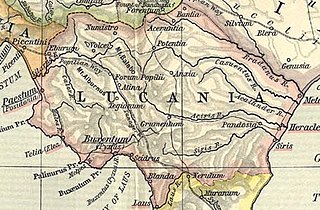
Lucania was a historical region of Southern Italy. It was the land of the Lucani, an Oscan people. It extended from the Tyrrhenian Sea to the Gulf of Taranto. It bordered with Samnium and Campania in the north, Apulia in the east, and Bruttium in the south-west, and was at the tip of the peninsula which is now called Calabria. It comprised almost all the modern region of Basilicata, the southern part of the Province of Salerno and a northern portion of the Province of Cosenza.

Pisciotta is an Italian town and comune of the province of Salerno, in the region of Campania.
Petilia or Petelia was a city name found in some ancient works of classical antiquity. It's widely accepted that in antiquity there were two cities with this name, both located in Southern Italy. One of them, Petilia, was located in ancient Lucania, while the second one, Petelia, was located on the coast of Bruttium.

Castellabate is a town and comune in the province of Salerno in the Campania region of south-western Italy. It is a member of the I Borghi più belli d'Italia association.

Ispani is a town and comune in the province of Salerno in the Campania region of south-western Italy.

Ogliastro Cilento is a town and comune in the province of Salerno in the Campania region of south-western Italy. As of 2011 its population was of 2,241.

Sapri is a town and comune in the province of Salerno in the Campania region of south-western Italy. It is one of the southernmost towns of the region of Cilento and its population is 6,783.
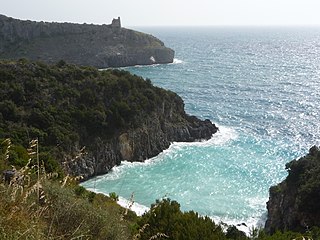
Cilento is an Italian geographical region of Campania in the central and southern part of the Province of Salerno and an important tourist area of southern Italy.
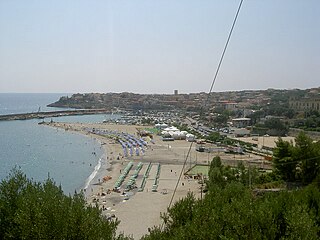
Marina di Camerota is an Italian town, the largest Civil parish (frazione) of Camerota, situated in the province of Salerno, Campania. In 2007 it had a population of 2,674.
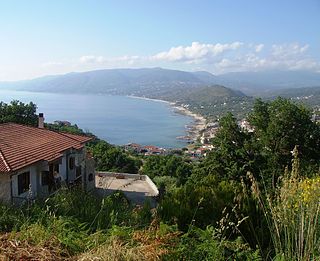
Palinuro is an Italian small town, the most populated civil parish (frazione) of Centola, Province of Salerno, in the Campania region. The name of the town is derived from Palinurus, the helmsman of Aeneas, as recorded in the fifth and sixth books of the Aeneid.

Policastro Bussentino is an Italian town and hamlet (frazione) of the municipality of Santa Marina in the province of Salerno, Campania region. It is a former bishopric, now titular see, and has a population of 1,625.

The Vallo di Diano is an Italian valley of the south-eastern side of Campania, in the province of Salerno.
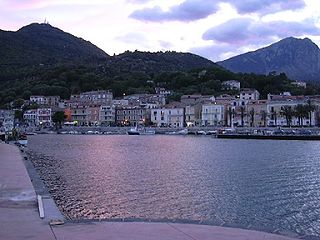
Scario is an Italian village and hamlet (frazione), the largest of the municipality of San Giovanni a Piro in the province of Salerno, Campania region. In 2011, it had a population of 1,124.

The Cilento Coast is an Italian stretch of coastline in Cilento, on the southern side of the Province of Salerno. It is situated between the gulfs of Salerno and Policastro, extending from the municipalities of Capaccio-Paestum in the north-west, to Sapri in the south-east.

The Salerno–Reggio Calabria railway is the most important north–south railway connection between Sicily, Calabria and the rest of the Italian peninsula. It forms the southern section of Corridor 1 of the European Union's Trans-European high-speed rail network, which connects Berlin and Palermo. Its southern part, between Rosarno and San Lucido is also used as an RFI freight route between the Port of Gioia Tauro and the Adriatic railway.

Capitello is a southern Italian village and hamlet (frazione) of Ispani, a municipality in the province of Salerno, Campania. As of 2009 its population was of 626.

Villammare is a southern Italian village and the only hamlet (frazione) of Vibonati, a municipality in the province of Salerno, Campania. As of 2009 its population was of 1,024.

The strada statale 18 "Tirrena Inferiore" is an Italian state road, connecting Campania and Calabria. It is among the longest and most important state highways in southern Italy, considering that it follows the Tyrrhenian coast, from Salerno to Reggio di Calabria.
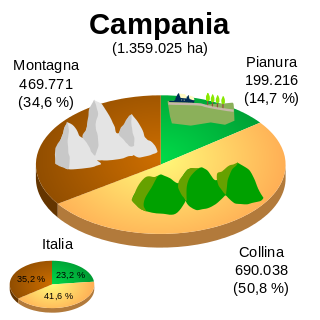
The geography of Campania illustrates the geographical characteristics of Campania, a region of Italy.


















